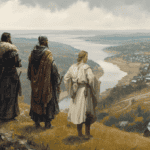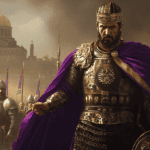
The Uprising of Ivaylo, which took place from 1277 to 1280, stands as a remarkable chapter in medieval European history. This peasant rebellion in Bulgaria not only achieved temporary success but also led to significant changes in the political landscape of the Second Bulgarian Empire. The revolt, led by a charismatic figure named Ivaylo, challenged the established order and placed a peasant on the imperial throne.
Background and Causes
The late 13th century was a tumultuous time for the Second Bulgarian Empire. The country was facing multiple challenges, both internal and external, which set the stage for the uprising:
- Mongol Invasions: The northeastern regions of Bulgaria, particularly Dobrudzha, had been suffering from repeated Mongol raids and looting for decades. The central authorities’ failure to effectively address this threat left the population vulnerable and disillusioned.
- Feudalization: The Second Bulgarian Empire was experiencing accelerating feudalization, which weakened state institutions and increased the burden on the peasantry.
- Incompetent Rule: Emperor Constantine Tikh’s reign was marked by ineffective governance, further exacerbating the problems faced by the common people.
- Economic Decline: The constant warfare and instability led to a general economic downturn, increasing the hardships faced by the peasants.
These factors combined to create a powder keg of discontent among the Bulgarian peasantry, setting the stage for a leader who could channel their frustrations into action.
Rise of Ivaylo
Into this volatile situation stepped Ivaylo, a figure shrouded in both history and legend. Contemporary Byzantine chroniclers described him as a swineherd, emphasizing his humble origins. Known by various names, including Bardokva (“radish” or “lettuce”) and Lakhanas (“cabbage” in Greek), Ivaylo emerged as an unlikely but formidable leader.
Ivaylo’s rise to prominence began in the spring or summer of 1277 in northeastern Bulgaria, where the Mongol devastation was most severe. He demonstrated exceptional military prowess by confronting and defeating a plundering Mongol unit. This victory was quickly followed by another, and by autumn, Ivaylo had successfully driven all Mongols out of Bulgarian territory.

Early Victories and Growing Support
Ivaylo’s success against the Mongols, a feat that had eluded the Bulgarian military for decades, catapulted him to fame. His popularity soared, and he began to attract followers from various segments of society, including discontented nobles. The people hailed Ivaylo as emperor, and many regions came under his control.
The rebellion gained momentum rapidly. Emperor Constantine Tikh, who had ruled Bulgaria since 1257, was slow to respond. His reign had been marked by a series of challenges, including conflicts with neighboring powers and internal strife. Constantine’s effectiveness as a ruler had been further compromised by a hunting accident in the 1260s that left him paralyzed from the waist down.
By the end of 1277, Constantine could no longer ignore the threat posed by Ivaylo’s rebellion. The emperor finally decided to take action, gathering a small army to confront the rebels. However, his physical condition severely hampered his ability to lead effectively, as he had to travel in a chariot due to his paralysis.
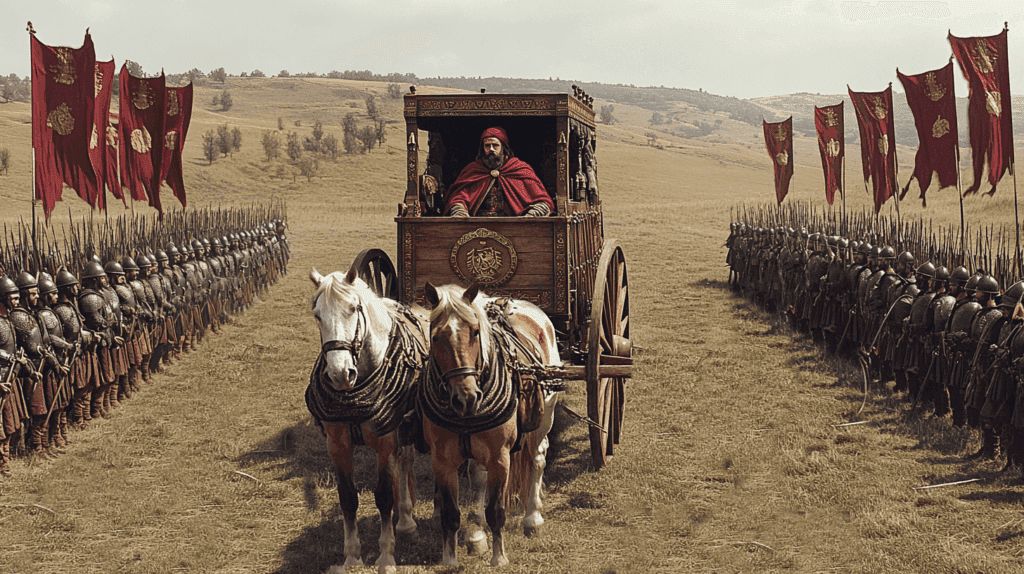
The Fateful Confrontation
As Constantine’s forces advanced, Ivaylo seized the opportunity to strike. The battle that ensued was a decisive one. Ivaylo’s forces, though largely composed of peasants, fought with determination and tactical skill. They managed to outmaneuver Constantine’s army, many of whom were likely demoralized by years of ineffective leadership.
The most dramatic moment of the battle came when Ivaylo personally confronted Emperor Constantine Tikh. In a scene that would become legendary, Ivaylo engaged the paralyzed emperor, who was unable to defend himself effectively.
Ivaylo’s justification for his actions was rooted in medieval concepts of honor and leadership. He claimed that Constantine had “done nothing to keep his honor in the battle”. This accusation struck at the heart of medieval ideals of kingship, which demanded that a ruler lead his troops personally and display courage in combat.
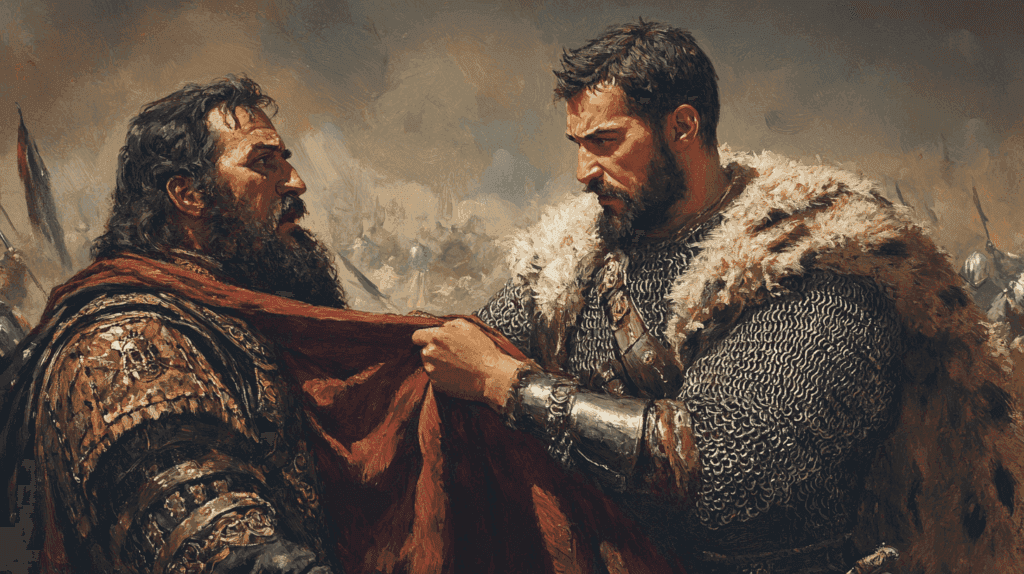
The Aftermath
The death of Constantine Tikh at Ivaylo’s hands marked a turning point in the rebellion. With the emperor slain and much of his army either defeated or having defected to the rebel cause, the path to Tarnovo, the capital, lay open.
In the wake of his victory, Ivaylo moved quickly to consolidate his power. He began to capture the country’s fortified cities, which surrendered to him one by one. By the spring of 1278, only Tarnovo remained outside his control.
Ivaylo’s Ascension to the Throne
In a shrewd political move, Ivaylo married Maria Palaiologina Kantakouzene, the widow of the slain emperor Constantine Tikh. This marriage legitimized his claim to the throne in the eyes of many and forced the nobility to recognize him as the new Emperor of Bulgaria. Ivaylo’s ascension marked a remarkable achievement – a peasant had risen to become the ruler of a medieval European state.

Byzantine Intervention and Mongol Threats
Ivaylo’s success alarmed the Byzantine Emperor Michael VIII Palaeologus, who saw an opportunity to intervene in Bulgarian affairs. Michael VIII sent Ivan Asen III, a son of a former Bulgarian emperor, to claim the Bulgarian throne. This move was backed by a large Byzantine army.
Simultaneously, Michael VIII incited the Mongols to attack Bulgaria from the north, forcing Ivaylo to fight on two fronts. This strategy put immense pressure on the new peasant emperor and his forces.
Military Campaigns and Victories
Despite facing enemies on multiple fronts, Ivaylo proved to be a capable military leader. He engaged in several successful campaigns:
- Defeat of the Mongols: Ivaylo initially suffered a defeat against the Mongols and was besieged in the fortress of Drastar. However, he managed to break the siege and continue his resistance.
- Victory in the Balkan Mountains: In June 1279, Ivaylo achieved a complete victory over a 10,000-strong Byzantine army led by Murin in the Kotel Pass.
- Second Byzantine Defeat: Just two months later, in August 1279, Ivaylo defeated another Byzantine force of 5,000 troops led by Aprin in the eastern Balkan Mountains.
These victories demonstrated Ivaylo’s military wisdom and helped maintain his position as emperor. Contemporary accounts describe him as fighting “with fury, achieving many feats” in these battles.
Challenges to Ivaylo’s Rule
Despite his military successes, Ivaylo faced significant challenges to his rule as many Bulgarian nobles remained skeptical of a peasant emperor and continued to oppose his rule. To the South the Byzantine Empire continued to undermine Ivaylo’s authority through military interventions and political maneuvering posed a constant threat. While in the North, the ongoing Mongol threat required constant vigilance and military action, straining resources and popular support.
These factors combined to create a precarious situation for Ivaylo, despite his earlier successes. The turning point came when the nobility in Tarnovo, seizing an opportunity during one of Ivaylo’s military campaigns, proclaimed George Terter I as the new emperor. This move significantly undermined Ivaylo’s authority and led to a rapid decline in his support.
Faced with diminishing backing and surrounded by enemies, Ivaylo made a fateful decision to seek aid from Nogai Khan, a powerful Mongol leader. This move, intended as a diplomatic action to secure support, ultimately led to Ivaylo’s downfall.
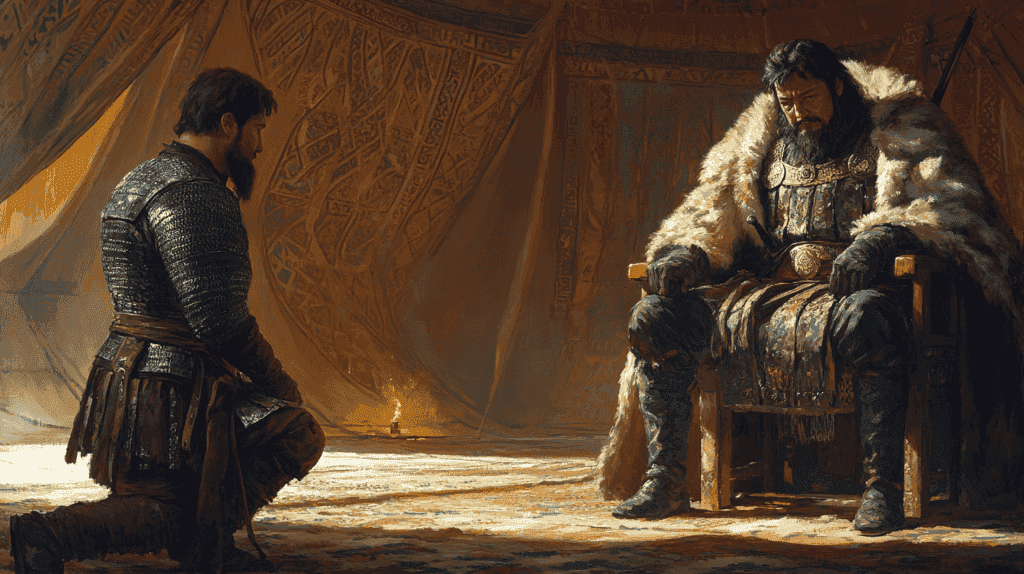
Ivaylo’s Final Days
At Nogai Khan’s court, Ivaylo initially received a warm welcome. However, the situation quickly turned against him
The Byzantine emperor Michael VIII sent Ivan Asen III to Nogai’s court with rich gifts, seeking to influence the Mongol leader against Ivaylo. Nogai Khan, married to an illegitimate daughter of Michael VIII, was swayed by Byzantine interests.
During a feast, Nogai Khan ordered Ivaylo’s execution, declaring him an enemy of the Byzantine Emperor. Ivaylo, along with his loyal associate Kasim beg, was murdered at the Mongol court in 1281, bringing an end to one of the most remarkable peasant uprisings in medieval European history.
Comparison with Other Peasant Revolts
The Uprising of Ivaylo stands out among medieval peasant revolts for several reasons:
- Temporary Success: Unlike many other peasant revolts, such as the English Peasants’ Revolt of 1381, Ivaylo’s uprising temporarily succeeded in placing a peasant on the throne.
- Military Achievements: Ivaylo’s victories against both Mongol and Byzantine forces demonstrated a level of military organization and strategy uncommon in peasant rebellions.
- Duration: The revolt lasted for several years (1277-1280), longer than many other peasant uprisings of the medieval period.
- Scale: The rebellion engulfed much of Bulgaria and involved significant military engagements, distinguishing it from more localized peasant revolts.
In this context, the Uprising of Ivaylo can be seen as part of a broader pattern of social unrest and changing power dynamics in medieval Europe.
While ultimately unsuccessful in establishing lasting change, the revolt left an indelible mark on Bulgarian history and continues to captivate historians and the public imagination. It serves as a reminder of the complexities of medieval society and the enduring human desire for justice and equality, even in the face of overwhelming odds.

